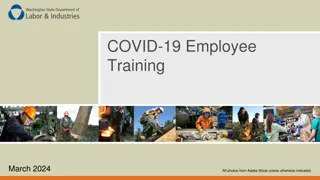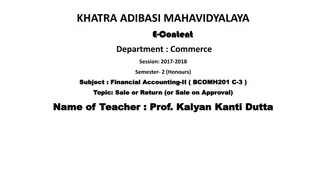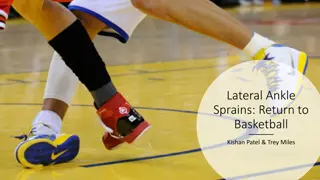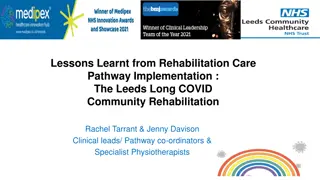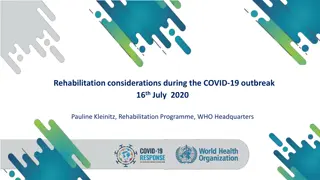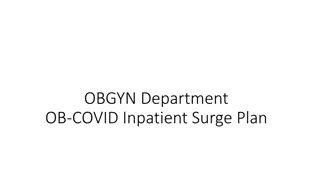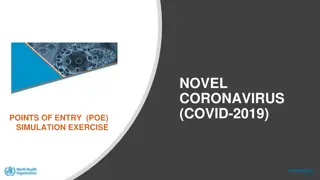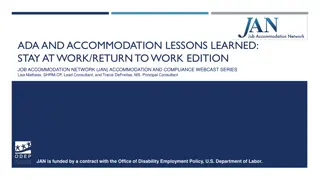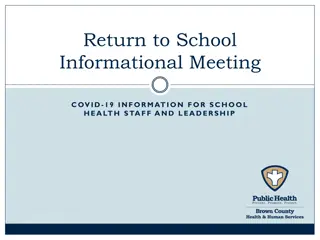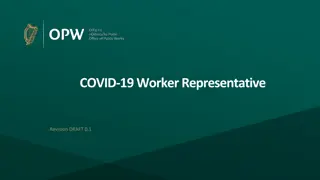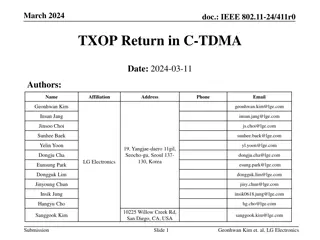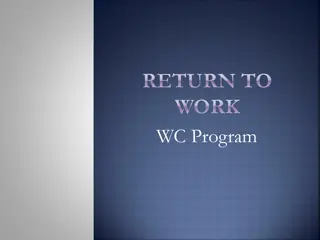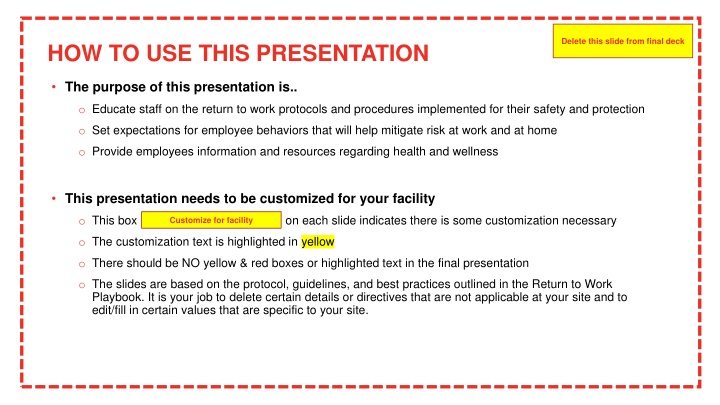
Workplace Safety Orientation: Customized Presentation for Staff Return
This presentation aims to educate staff on return-to-work protocols, set expectations for risk mitigation, and provide health and wellness resources. Customization is essential for facility-specific details. Topics covered include COVID-19 response, symptom awareness, self-screening, isolation protocols, social distancing, hygiene, and PPE. Guidance is provided for changes to schedules, facility layouts, cleaning responsibilities, and employee roles in ensuring a safe work environment.
Download Presentation

Please find below an Image/Link to download the presentation.
The content on the website is provided AS IS for your information and personal use only. It may not be sold, licensed, or shared on other websites without obtaining consent from the author. If you encounter any issues during the download, it is possible that the publisher has removed the file from their server.
You are allowed to download the files provided on this website for personal or commercial use, subject to the condition that they are used lawfully. All files are the property of their respective owners.
The content on the website is provided AS IS for your information and personal use only. It may not be sold, licensed, or shared on other websites without obtaining consent from the author.
E N D
Presentation Transcript
Delete this slide from final deck HOW TO USE THIS PRESENTATION The purpose of this presentation is.. o Educate staff on the return to work protocols and procedures implemented for their safety and protection o Set expectations for employee behaviors that will help mitigate risk at work and at home o Provide employees information and resources regarding health and wellness This presentation needs to be customized for your facility o This box on each slide indicates there is some customization necessary Customize for facility o The customization text is highlighted in yellow o There should be NO yellow & red boxes or highlighted text in the final presentation o The slides are based on the protocol, guidelines, and best practices outlined in the Return to Work Playbook. It is your job to delete certain details or directives that are not applicable at your site and to edit/fill in certain values that are specific to your site.
Our COVID-19 Response Signs & Symptoms of COVID-19 Daily Self-Screening for Symptoms Isolation Protocol for Symptomatic Employees Social Distancing Measures Personal Hygiene Disinfection Measures Personal Protective Equipment (PPE) Agenda
Customize for facility Changes to schedule, facility, cleaning and responsibilities What was done during shutdown Work schedule changes (staggered shifts, job rotation, meetings, etc.) Facility changes (doors, timeclocks, cafeteria, work station changes, etc.) Dedicated cleaning resources What is everyone s role when returning to work (social distancing, cleaning, personal hygiene) Remember, if you are feeling ill at any time during your shift, tell X or X immediately.
Customize for facility Screening for Symptoms of COVID-19 Symptoms can include fever, cough and shortness of breath In the interest of ensuring a safe and healthy work environment, we recommend that you voluntarily monitor your health by completing a daily self-assessment before coming to work. o (see the Self-Screening Information hand-out/email)
At-Risk Employees Reasonable Accommodations Upon request by an employee to the site Human Resources representative, the company will provide reasonable accommodations in accordance with applicable laws to employees who, as determined by the World Health Organization or local health authority, are at a higher risk for severe illness from COVID-19. Employees who are at a higher risk may include the following: o Employees aged 65 or older; o Employees with chronic lung disease or moderate to severe asthma; o Employees who have serious heart conditions; o Employees who are immunocompromised; o Employees with severe obesity (body mass index [BMI] of 40 or higher); o Employees with diabetes; o Employees with chronic kidney disease undergoing dialysis; o Employees with liver disease; and o Employees who are pregnant. This protocol will remain in effect until the Global Prevention Team has determined, based on guidance from the global and local health authorities and the applicable governmental requirements, that it is safe to terminate. The Global Prevention Team and/or Operational Leadership will advise our facilities once this determination has been made.
Customize for facility On-Site Screening for Symptoms of COVID-19 To help prevent the spread of COVID-19 and reduce the potential risk of exposure to our employees and visitors; temperature and health screening is in place at all company sites until the Global Prevention Team has determined, based on guidance from the global and local health authorities and the applicable governmental requirements that it is safe to discontinue. Your participation is important to help us take precautionary measures to protect you and everyone in the building! Thank you! Health & Wellness On-Site Screening Process: H&W team asks/presents each employee the screening questions H&W team assesses employees for any overt signs or symptoms H&W team takes each employee s temperature using a non-touch thermometer Other details: The Health & Wellness team is coordinated by: [person] The screening process is conducted for each employee prior to the shift Before the shift, employees should report to [the screening location] IF employee reports symptoms or direct exposure to COVID-19, the employee will be invited to [insert area of facility] IF temperature is 38 C (100.40F) or higher, or the employee exhibits visible symptoms of illness consistent with COVID-19, the employees will be invited to [insert area of facility]
Customize for facility Symptomatic Employee Isolation Protocol (at work) If you feel symptomatic for COVID-19 at work, contact your [leader] immediately o Radio/telephone communications are preferable. o The isolation team and coordinator must don the appropriate PPE prior to providing assistance to the symptomatic employee. The [leader] take the symptomatic employee to the designated isolation area for further evaluation o From this point forward, all employees coming into direct contact (less than 1 meter) with the symptomatic employee are required to use all PPE Once the symptomatic employee arrives at the isolation room: o Employee is given a mask and gloves (to help protect other employees and prevent spread any potential virus) o All employees continue to maintain 1-2 meters (3-6 feet) distance at all times The Isolation Coordinator completes a COVID-19 Case Form with the symptomatic employee If the employee is suspected to have COVID-19 symptoms, the employee is sent home and/or directly to health center and must seek and present medical clearance to return to work
Customize for facility Suspected Symptoms / Positive COVID-19 Testing If an employee suspects they have symptoms of COVID-19 If an employee tests positive for COVID-19 Employee is to contact local Human Resources team prior to discuss steps and documentation that may be required prior to return to company premises. All facility employees will be notified via [communication channel] (reporting/symptomatic employee will remain anonymous) Employee must follow the Self Quarantining and Return to Work protocol to ensure the safety of those around them. o [Either provide handout or review details] All facility employees will be notified via [communication channel] (reporting/ill employee will remain anonymous) If symptoms are suspected in the facility, all surfaces touched by the employee will be thoroughly cleaned and disinfected Employees coming into direct exposure (less than 1 meter without mitigation) with the COVID-19 positive employees will be directed to follow the self-quarantine protocol and must seek and provide medical clearance to return to work.
Customize for facility edit these pages to show how your facility has interpreted and put in action the social distancing protocols Social Distancing & Disinfecting Protocol and Measures
Our Collective Efforts to Prevent Spread & Avoid Infection Social distancing is a simple yet very effective mechanism to prevent potential infection, that relies on simple distance to avoid infection. In practice this means: o Staying at least 1-2 meters (3-6 feet) from others as a normal practice o Eliminating contact with others, such as handshakes or embracing coworkers, visitors, or friends o Avoiding touching surfaces touched by others to the extent feasible o Avoiding anyone that appears to be sick, or is coughing or sneezing Social distancing in our manufacturing environment includes production lines, cafeterias, common areas, entrance/exit areas of work locations, and offices. 1-2 meters
Our Collective Efforts to Prevent Spread & Avoid Infection Disinfection measures have been put in place and are taken routinely, based on frequency mentioned to disinfect work place surfaces, chairs, tables, etc. and protect employees. o The facility was completely sanitized and disinfected before re-opening o This baseline of clean will be upheld with the Disinfection Protocol o The Disinfection Protocol will be followed regularly whereas the Deep-Cleaning and Disinfection Protocol is triggered when an active employee is confirmed positive for COVID- 19 by a medical doctor; the deep-cleaning would be carried out by an external, professional service. The Disinfection Team is led by: [person] o The disinfection team is trained and equipped to use special Personal Protective Equipment to deal with potentially harmful chemicals used in sanitization. All employees have an active part in disinfection o Good personal sanitary practices including washing hands after bathroom use are necessary and expected o Covering your cough, maintaining social distancing, and cleaning your work or other visited areas are important in keeping yourself and others safe o You will be supplied with [insert available supplies & location]
Customize for facility Shift Changes Shift changes will be managed thoughtfully to reduce infection risk, and to leverage the opportunity they present to ensure optimal disinfection of the workplace. Security stationed near entry doors Time clocks wiped off each time it is touched by an employee Employee is stationed to observe the time clock at a safe 2 meter distance to disinfect the clock Start/end times staggered Designated entrances Doors propped open Security stationed near entry doors No punching in and out for a few weeks Facility / Disinfectant Crew Do not touch the time clock or entry door handle with an exposed finger(s) or hand Do not touch your face before you have had a chance to wash your hands Turn styles, lead with elbow Avoid gathering in crowds Remain in your car until your scheduled window of start time Ensure social distancing is maintained while you wait in line to enter the plant When you talk to someone in line, do not speak directly at them All Employees
Customize for facility Manufacturing Workstations Social distancing in manufacturing is intended to provide a safe environment reducing risk of any potential person to person infection. Common surfaces (including control buttons, tools and more) in the workstation disinfected at the end of each shift, minimum Conveyer belts disinfected at least once in the morning and afternoon Moveable trays/containers disinfected based on use; once per shift if contacted by 1 person only, otherwise, between users. Forklifts disinfected after each use Work stations have been arranged 1-2 meters apart Signage placed in workstation about the desired position of the operators Design implemented to prevent operators overlapping Stop and Go controls, so operators perform their work during the Stop portion of the line. Floor limits for workstations are placed in the conveyor operations For discrete operations work stations design, mechanical means to aid transportation (inclined shelves, small inclined/gravity assisted rods, push boards, etc.) on finished product Facility / Disinfectant Crew All Employees Self-cleaning of the work space is encouraged multiple times during the shift with special attention of the most used surfaces such as fixtures, pegs, holders, boards, containers, shelves, etc. Avoid touching your face and wash thoroughly with soap and water several times during the work hours. Ensure social distancing is maintained
Customize for facility Breaks and Cafeteria Social distancing in manufacturing is intended to provide a safe environment reducing risk of any potential person-to-person infection. Break times separated by 10 minutes to allow enough time to wipe tables, seats, all surfaces, refrigerator, vending machines and microwave ovens after each use. Provide supplies for employees to clean after themselves Tables and chair surfaces, dispensers, vending machines, etc. are cleaned generally 3 or more times per shift to include after all breaks and meals Break times are staggered to limit number of employees Chairs and space have been limited/ removed/ blocked off Signage placed on tables Max capacity is posted One to two employees posted to observe the safe 2 meter (6 feet) distance and to disinfect Full-service cafeteria closed Food trucks are available Outside pavilions are available Markers are placed on the floors to ensure distance between people in line Facility / Disinfectant Crew All Employees Clean up after yourself and disinfect surfaces you touch Wash you hands or use hand sanitizer before and after lunch Ensure social distancing is maintained Do not arrive early to break
Customize for facility Bathrooms Disinfectant supplies are provided for employees to clean up after themselves Bathrooms are disinfected at least four time per day Urinal and sink stations have been marked for non-use so that the distance between each is 1-2 meters (3-6 feet) Max capacity is posted One or two employees will be stationed to observe the distancing minimum Facility / Disinfectant Crew Wash hands When possible, use elbow to open doors or press buttons Ensure social distancing is maintained All Employees
Customize for facility Locker Rooms All general walls and floors disinfected periodic, where frequently touched. Hard surfaces mopped daily Doors, windows and other commonly touched objects disinfected at least four times per day Lockers reassigned to limit capacity and increase distancing Lockers limited to only employees with accommodations Shelves placed in lunch room to keep lunch boxes Facility / Disinfectant Crew When possible, use elbow to open doors or press buttons Follow shift start and end times and break and lunch schedule. Ensure social distancing is maintained All Employees
Customize for facility Common Areas Social distancing is a simple yet very effective mechanism to prevent potential infection, that relies on simple distance to avoid infection All general walls and floors disinfected periodic, where frequently touched. Hard surfaces mopped daily Doors, windows and other commonly touched objects disinfected at least four times per day Facility / Disinfectant Crew When possible, use elbow to open doors or press buttons Avoiding touching surfaces touched by others to the extent feasible Ensure social distancing is maintained Avoid non-essential gatherings Eliminate contact with others, such as handshakes or embracing coworkers, visitors, or friends Avoiding anyone that appears to be sick, or is coughing or sneezing All Employees
Customize for facility Transportation Individual commuting to and from work is preferable however when using transportation public or provided by a third party the following guidelines shall be followed: Bus drivers must wear a mask all the time while providing the service. Temperature check of drivers must be done before the start of the route and must be documented Service provider must disinfect the buses multiple times following EH&S requirements and as a minimum: Right before starting a route to pick up employees Right after employees arrived to company facilities Bus driver are considered contractor/visitor and must follow the company s contract/visitor protocol Facility / Disinfectant Crew Employees must not use buses if they suspect they are sick or if they have symptoms such fever, or difficulty to breath or have been in contact in the past 7 days with other people confirmed sick of any respiratory disease. Adhere to social distancing guidelines All Employees
Customize for facility Offices All general walls and floors disinfected periodic, where frequently touched. Hard surfaces mopped daily Doors, windows and other commonly touched objects disinfected at least four times per day Desks reassigned or blocked to ensure separation of employees between 1-2 meters (3-6 feet) Cubicles have dividers when minimum distance can not be met Meeting rooms organized to hold no more than 10 chairs with appropriate spacing between people Remote work may be assigned when possible to reduce number of employees in facility Facility / Disinfectant Crew When possible, use elbow to open doors or press buttons Self-cleaning of the work space is encouraged multiple times during the shift with special attention of the most used surfaces such keyboards, monitors, chair arm rest, desks, cubicle divider among others Ensure social distancing is maintained All Employees
1) Washing hands is the most effective way to reduce the spread of infectious diseases. When should you wash your hands? Presume your hands are contaminated with viruses and bacteria after touching common surfaces, as well as any surfaces you touch thereafter. Entering the site and back to home Before and after food preparation and before eating & drinking Before and after treating a cut or wound After touching your nose or mouth Before and after toilet use After processing garbage After blowing your nose, coughing or sneezing After handling an animal or animal waste After changing diapers or cleaning up a child who has gone to the bathroom After visiting sick people Before taking medication NOTE: Presume your hands are contaminated with viruses and bacteria after touching common surfaces, as well as any surfaces you touch thereafter. When washing hand with soap and water: Wet your hands with clean running water and apply soap. Use warm water if it is available Rub hands together to make a lather and scrub all surfaces. Continue rubbing hands for 20 seconds: Sing the "Happy Birthday Song! Rinse hands well under running water Dry your hands using a paper towel or air-dryer Use alcohol-based hand sanitizer liberally if soap and water are not available.
2) Do NOT touch your FACE, including your mouth, eyes, nose or ears. Viruses that get onto your hands by touching common surfaces cannot harm you unless you physically transfer them to an entry portal into the body, so do not touch your face. If you are sick, touching your face will contaminate your hands, and any common surfaces you touch continuing the chain of infection. 3) Cover coughs/sneezes. Never cough or sneeze into your hands, as they then pass viruses to common surfaces and infect others. Use a tissue or cough and sneeze into the bend of your elbow COVID-19 on your hands causes no harm, until you touch your face, or contaminate others who do so. Your eyes, nose, and mouth are the primary entry points for this and many other viruses and bacteria. o If the face is inadvertently touched, it should be rinsed with soap and warm water. 4) Keep personal devices clean. Ensure personal items that are touched, and especially those that touch your face (e.g. mobile phone) are kept clean. Avoid touching them after you have touched common surfaces and clean them frequently as needed.
PPE Some employees may be required to use Personal Protective Equipment; PPE is used for employees that may come into direct contact with COVID-19 positive employees and for disinfectant team members to protect their skin from regular use of cleaning chemicals. How to wear masks o Availability Our top priority is protecting our people. Based on CDC findings, the company does not require or recommend that our employees wear gloves except for: 1) Isolation Team Members and, 2) Those performing disinfection of common surfaces per the Playbook. However, the company will provide gloves if mandated by local laws. o Availability o Chart of PPE supplies, frequency of changing, how to use it/ remove it
Customize for facility Health Care Options Insert health and wellness options for employees on this slide.
Contact Information Local HR phone number Local EHS phone number Facebook page/ social media Compliance Hotline: World Health Organization (WHO) https://www.who.int/emergencies/diseases/novel-coronavirus-2019

